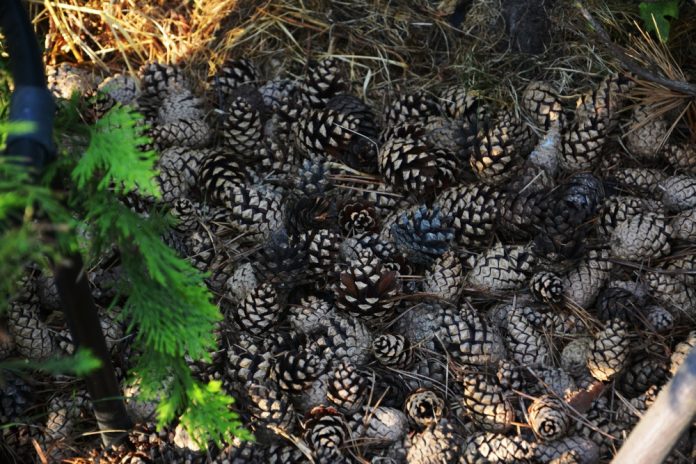Located in masses on the forest floor, pine cones are abundant and easy to find, no matter what time of year it is. These little woody things come in all sorts of shapes and sizes, depending on the conifer from which they fell, and can be put to good use as material for a variety of craft projects.
If you have a few evergreen trees in your garden, pine cones may seem more of a nuisance than a gift. But pine cones are a free renewable resource with many applications in the garden. Collecting them is another clever way to garden for free.
- Make pine cone mulch
Spreading a layer of mulch over your garden beds helps the soil retain moisture, suppresses weeds, keeps the soil cool and provides an attractive cover for bare soil. Using organic mulches also means that as they break down and decompose, nutrients will be released to improve soil fertility.
While wood chips, coconut husks, straw and shredded bark are some of the mulch options available for purchase, mulch storage can easily cost hundreds of dollars depending on the square footage of the area. Mulch should be applied to a depth of 2 to 3 inches and should be reapplied every year or two.
A no-cost alternative to bagged mulch is to use the waste that your yard generates each year. Backyards are often abundant in several materials worthy of mulch, such as grass clippings, leaf mold, compost, pine needles and pine cones.
In the natural environment, pine cones are responsible for distributing the seeds of the conifer; they open their scales to release the seeds during dry periods and close when they are wet. They can remain on the ground for years to repeat their reproductive cycle over and over again. In the garden, this means they can be used as an incredibly durable mulch that will take centuries to decompose. They are also naturally resistant to mold and mildew.
You can mulch with pine cones by keeping them whole. Or you can separate them by processing them with a shredder or running them through a lawn mower. Another method is to simply hit them repeatedly with the back of a shovel – inelegant but very effective.
Since pine cones are somewhat acidic, use them around acid-loving plants, such as blueberries and azaleas. Alternatively, you can sprinkle baking soda on the soil while applying the mulch to help neutralize the soil pH.
- Add pine cones to your compost pile
Pine cones are also an excellent source of carbon (or “browning”) in the compost pile. They are primarily composed of ash, lignans, and tannins, and when fully decomposed, will add these beneficial elements to your finished hummus.
While its slow degradation is ideal for mulch, you’ll want to speed up the process in the compost pile by chopping it into smaller pieces first. For quick composting results, use a chipper or shredder to create a very fine sawdust consistency before adding it to the pile.
- Build a Ladybug Hotel
Like a world in miniature, the garden is home to a thriving insect population. By encouraging certain beneficial insects to come home to your garden, you will enlist the help of many workers who will tirelessly pollinate your plants, break down dead plant tissue, and tackle garden pests. And by simply letting nature do its job, you can avoid the use of pesticides and other harmful chemicals.
Ladybugs are some of the most prized inhabitants of the garden. Don’t let their friendliness fool you,
Ladybugs are some of the most prized inhabitants of the garden. Don’t let their friendliness fool you, they are voracious hunters and will devour at least 50 aphids, mites, whiteflies or mealybugs a day.
Building a bug hotel is a great way to encourage ladybugs and other insects to stay. While there are all sorts of salvageable materials you can use to give them a place to nest and hibernate – such as hollow reeds, branches, leaves, bark and holes drilled in logs – pine cones are a great place to set up shop during the winter.
You can provide them with a pine cone-shaped room in a multi-insect home. For a quick solution, dedicated to ladybugs, this DIY requires only wire mesh or netting, string and several pine cones; hang it near your garden in a sheltered area protected from heavy rain. Another option is to set up a wall-mounted planter (like this one) and fill it with pine cones.
- Make a pine cone feeder
Filling your yard with activity and song, birds are not only fun to watch, they also offer free protection from pests. Birds feed on caterpillars, grubs, mosquitoes and beetles, and often consume the seeds of weeds and other unwanted plants in the garden.
You can make your garden an attractive place for birds to hunt and raise their little cultivars your own birdseed.
Any pine cone will do, but a large, round one will provide the best surface area. Remove a few scales from the pine cone to create extra space for food. Cut the pine cone into peanut butter or suet, then roll it in your favorite birdseed mix. Tie it with string or decorative ribbon and hang it from a tree branch.
CLICK NEXT PAGE BELOW TO CONTINUE READING …










